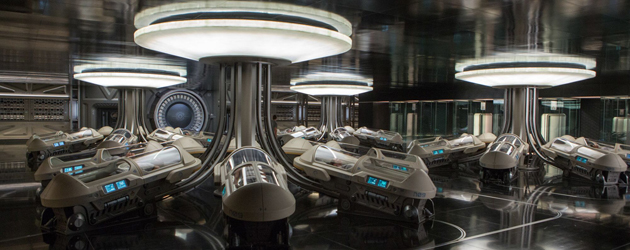Guy Hendrix Dyas 2.0

I came up through ILM so my background is in CGI. I see the guys in visual effects as my brothers in arms. They’re there to help support the vision. Not everything I design can be realized in the time frame or in the budget that I have. I rely heavily on visual effects to help finish off the look of the film. I look forward to the day when somebody says we’re going to do a film and you’re going to be in it. That just means more design.
AS: When you design, are you in communication with the VFX supervisor from the beginning?
GHD: Erik Nordby, who was phenomenal on Passengers, came onto the film about halfway into our period here at SONY. Like Rodrigo he was a true professional, very thoughtful, and a big supporter of the vision. He came in and said, I want to make this ship work and look real.
In the huge shopping mall, we build the 350’ of it and had his help topping it up to the 5 levels. It was my good friend Erik who completed our vision and worked tirelessly to match the illustrations. And in some cases improve on them. Hats off to them for finishing off the bits of the set we just physically couldn’t do because we’re not in space! For the exterior of the ship, the design was given to them to implement and apart from two or three airlock sections that I had to build, all of the shots of the ship flying by are attributed to them and their amazing work.
AS: You’ve spent a lot of time thinking about the future in your design. Do you see human civilization eventually expanding into space?
GHD: It’s always that schoolboy dream, isn’t it? Every now and then we make huge leaps in terms of space exploration but it still takes time. Even in designing the exterior of the Passengers spaceship I was very cognizant of the fact it would have been designed and built as sections like the space station, over a period of 60 years. You’ll notice that the core of the ship is designed in an almost traditional NASA style. But as you spread out the ship becomes more futuristic because over sixty years design and technology would be moving forward. And so you see a range of architectural styles and materials on the ship to support that passing of time.
AS: Any advice for young people going into the field of production design?
GHD: There’s no trickery to becoming a designer. I was very lucky in that I just love what I do. And I spend hours and hours working and designing, whether it be weekends or holidays, because that’s what I believe I’m here on the Earth to do. I’ve found my calling. When you find your calling you never actually see it as work. You make yourself very available because you’re excited. If you do a good job eventually somebody’s going to say you should be designing. In my case I was found and given the opportunity by Bryan Singer, the great director of the X-Men series and The Usual Suspects. He picked me out of nowhere to design his initial TV show, Battlestar Gallactica. The show didn’t happen for me, although ironically they did use all my designs. And won an Emmy with it! But we went on to do X-Men 2 together as a wonderful consolation prize. So that was my first film. I’ve always considered myself very, very lucky.